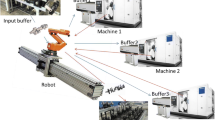Abstract
This paper studies robot speed control decisions and the energy consumption objective in a cyclic robotic cell scheduling problem. The study considers a two-machine flow shop cell that produces multiple part types. A robot handles the parts between the machines and buffers. We assume that the energy consumption of the robot during a move is a convex function of its speed. The problem is to sequence the parts, construct a robot move sequence, and plan the robot’s speed levels to minimize two conflicting objectives: cycle time and energy consumption of the robot. We propose mathematical models that find Pareto-efficient solutions to the problem. For large instances, we propose heuristic search algorithms. Numerical results show that integrating robot speed decisions into the scheduling problem leads to significant energy saving.















Similar content being viewed by others
Data availability
The data for the problem instances solved in our computational study is available at https://data.mendeley.com/datasets/fmm8c3zkkk/2.
References
Aktürk MS, Atamtürk A, Gürel S (2009) A strong conic quadratic reformulation for machine-job assignment with controllable processing times. Oper Res Lett 37(3):187–191
Alizadeh F, Goldfarb D (2003) Second-order cone programming. Math Program 95:3–51
Aneja Y, Kamoun H (1999) Scheduling of parts and robot activities in a two machine robotic cell. Comput Oper Res 26(4):297–312
Barnett N, Costenaro D, Rohmund I (2017) Direct and indirect impacts of robots on future electricity load. In: ACEEE summer study on energy efficiency in industry. The American Council for an Energy-Efficient Economy (ACEEE), pp 1–9
Błażewicz J, Sethi SP, Sriskandarajah C (1989) Scheduling of robot moves and parts in a robotic cell. École des hautes études commerciales
Bukata L, Šůcha P, Hanzálek Z et al (2017) Energy optimization of robotic cells. IEEE Trans Ind Inf 13(1):92–102
Bukata L, Šůcha P, Hanzálek Z (2019) Optimizing energy consumption of robotic cells by a branch & bound algorithm. Comput Oper Res 102:52–66
Crama Y, Kats V, Van de Klundert J et al (2000) Cyclic scheduling in robotic flowshops. Ann Oper Res 96(1–4):97–124
Dawande M, Geismar H, Sethi SP et al (2005) Sequencing and scheduling in robotic cells: recent developments. J Sched 8(5):387–426
Gadaleta M, Berselli G, Pellicciari M et al (2021) Extensive experimental investigation for the optimization of the energy consumption of a high payload industrial robot with open research dataset. Robot Comput Integr Manuf 68(102):046
Gilmore PC, Gomory RE (1964) Sequencing a one state-variable machine: a solvable case of the traveling salesman problem. Oper Res 12(5):655–679
Gultekin H, Gürel S, Taspinar R (2021) Bicriteria scheduling of a material handling robot in an m-machine cell to minimize the energy consumption of the robot and the cycle time. Robot Comput Integr Manuf 72(102):207
Günlük O, Linderoth J (2012) Perspective reformulation and applications. In: Lee J, Leyffer S (eds) Mixed integer nonlinear programming. Springer, New York, pp 61–89
Gürel S, Gultekin H, Akhlaghi VE (2019) Energy conscious scheduling of a material handling robot in a manufacturing cell. Robot Comput Integr Manuf 58:97–108
Gürel S, Gultekin H, Emiroglu N (2023) Scheduling a dual gripper material handling robot with energy considerations. J Manuf Syst 67:265–280
Hall NG, Sriskandarajah C (1996) A survey of machine scheduling problems with blocking and no-wait in process. Oper Res 44(3):510–525
Hall NG, Kamoun H, Sriskandarajah C (1997) Scheduling in robotic cells: classification, two and three machine cells. Oper Res 45(3):421–439
International Federation of Robotics (2022) World robotics 2022. https://ifr.org/downloads/press2018/2022_WR_extended_version.pdf. Last accessed 2023-03-10
Kirkpatrick S, Gelatt CD, Vecchi MP (1983) Optimization by simulated annealing. Science 220(4598):671–680
Levner E, Kats V, de Pablo DAL et al (2010) Complexity of cyclic scheduling problems: a state-of-the-art survey. Comput Ind Eng 59(2):352–361
Li Z, Tang Q, Zhang L (2016) Minimizing energy consumption and cycle time in two-sided robotic assembly line systems using restarted simulated annealing algorithm. J Clean Prod 135:508–522
Nilakantan JM, Huang GQ, Ponnambalam SG (2015) An investigation on minimizing cycle time and total energy consumption in robotic assembly line systems. J Clean Prod 90:311–325
Nilakantan JM, Ponnambalam SG, Huang GQ (2015b) Minimizing energy consumption in a U-shaped robotic assembly line. In: 2015 international conference on advanced mechatronic systems (ICAMechS), pp 119–124
Paryanto P, Brossog M, Bornschlegl M et al (2015) Reducing the energy consumption of industrial robots in manufacturing systems. Int J Adv Manuf Technol 78(5):1315–1328
Sethi SP, Sriskandarajah C, Sorger G et al (1992) Sequencing of parts and robot moves in a robotic cell. Int J Flex Manuf Syst 4(3–4):331–358
Silver E, Pyke D, Peterson R (1998) Inventory management and production planning and scheduling. Wiley, Hoboken
UN Department of Economic and Social Affairs (2022) Energy statistics pocketbook 2022. https://unstats.un.org/unsd/energystats/pubs/documents/2022pb-web.pdf, Last accessed on 2023-03-10
U.S. Energy Information Administration (2023) What is U.S. electricity generation by energy source? https://www.eia.gov/tools/faqs/faq.php?id=427 &t=3. Last accessed on 2023-03-10
Acknowledgements
The authors thank three anonymous referees for their comments and suggestions that significantly improved this paper.
Author information
Authors and Affiliations
Corresponding author
Additional information
Publisher's Note
Springer Nature remains neutral with regard to jurisdictional claims in published maps and institutional affiliations.
Rights and permissions
Springer Nature or its licensor (e.g. a society or other partner) holds exclusive rights to this article under a publishing agreement with the author(s) or other rightsholder(s); author self-archiving of the accepted manuscript version of this article is solely governed by the terms of such publishing agreement and applicable law.
About this article
Cite this article
Aydoğan, Ç., Gürel, S. Energy efficient scheduling of a two machine robotic cell producing multiple part types. Flex Serv Manuf J (2024). https://doi.org/10.1007/s10696-023-09528-4
Accepted:
Published:
DOI: https://doi.org/10.1007/s10696-023-09528-4



